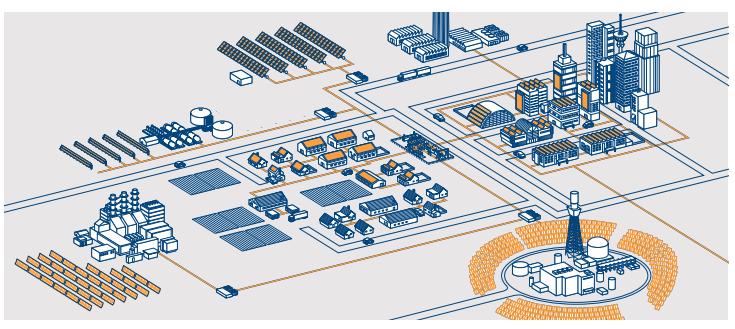Operators of renewable energy sites have noted a number of different design and performance issues that have not always been properly addressed during the development of the projects. These issues have included transient over-voltages, harmonic problems, transformer saturation, power factor, reactive power, and voltage control. ABB has been a major supplier of equipment for renewable power development for many years. Over these years, the company has observed a number of incidents and problems that resulted from an incomplete understanding of the requirements for designing and properly specifying the equipment.
Some examples include the following:

ABB has the expertise to review interconnection requirements, such as those from a wind or solar farm, and help develop optimum solutions for meeting the requirements.
- Step-up transformers have failed at a number of wind farms and solar farms due to the total loading of the transformers being more than specified. This was particularly true concerning the lack of defining the harmonic loading on the transformers.
- Harmonics from the renewable generation have been amplified until the harmonic over-voltages failed arresters and damaged step-up transformers. These lower order resonant modes are due to the total capacitance of the extensive cable system and sometimes a combination of the cables and power factor correction shunt capacitor banks.
- Arresters and transformers have failed when faults have disconnected feeders with induction generators still connected and the ground reference has been lost. This results in high over-voltages on un-faulted phases.
- High levels of harmonics have been measured when inverters for energy storage injected a low level of dc current into the transformer and saturated the transformer.
- Switching cable feeders with extensive cables or switching shunt capacitors on the collector system or on the nearby high voltage system can result in high transients being focused on some locations of a collector system resulting in repeated step-up transformers failing in the same location.
ABB has observed many cases of equipment failure due to the problems described above, but solutions are readily available. For example, eliminating the loading problems in the first Item (step-up transformers) above is just a matter of properly specifying the transformers and specifying the k-factor or the harmonic loading. This is one of area being addressed by a few wind-turbine vendors who are now providing information on how to specify transformers for their wind turbine generators.
Harmonic loading, DC injection, voltage ripple, and voltage range of operation are key areas that influence the operation of the transformer.
One trend in the industry, now widely seen in wind and starting in solar, is to provide specification information for the transformers used for the particular technology. ABB recommends specifications for transformers to withstand 110% of nominal voltage meaning that the transformers are expected to withstand 38 kV for normal (34.5 kV) operation. Typically, transformers designed per ANSI standards can handle up to 105% of the rated voltage. However, the growing trend to overexcite transformers to as much as 115% has been known to cause partial discharge, and even failure in some cases. These operating conditions and factors must be specified to the manufacturer in advance so changes can be made to the design of the transformer to address them.
Harmonic problems mentioned in the second item are more of a challenge with some technologies than others. In wind, for example, the full back-to-back conversion technology generates more harmonics than the doubly-fed induction generators with smaller converters, but in weak systems even harmonics from doubly-fed induction generators may cause problems. The solution is to conduct harmonic studies for those technologies that have had harmonic problems and issues.
The one issue that is the “silent killer” of transformers is the transients discussed in Item 5 above. Most renewables systems will not experience this type, but ABB has observed some step-up transformers fail due to this phenomenon.
One configuration that can lead to amplification of transient voltages is the switching of shunt capacitor banks on the higher voltage system near the power transformers that connect the renewable collector system. Solutions may include synchronized closing of the shunt capacitor banks and adding additional arresters on the collector system.
As renewable generation continues to account for a larger part of total system generation, interconnection requirements are requesting renewable sources to provide some of the same services that conventional generation provides. Some of these requirements include low-voltage ride through, power ramp rates, and power response to system frequency disturbances.ABB has reviewed and studied many of these issues and they are summarized in this paper.
The renewable energy sources that have been studied in the last few years include wind generation, solar photo voltaic (PV) generation, fly-wheel energy storage, and sterling-cycle-solar generation.
This ABB paper discusses the issues by the type of problem or issue that has occurred. As a manufacturer of most equipment and systems within utility scale renewable power plants, ABB has provided studies and evaluations for all of these problems to resolve past issues and prevent future failures and mis-operation of equipment. ABB also has the expertise to review interconnection requirements and help develop optimum solutions for meeting the requirements. The following sections explore several specific potential issues in more detail.
For the full paper:
Or view ABBs entire magazine online at:
http://www.lead-central.com/VenusSwitchboard/ViewInBrowser/5601debc-0394-4b41-8b53-ae05453b560f
Filed Under: News




